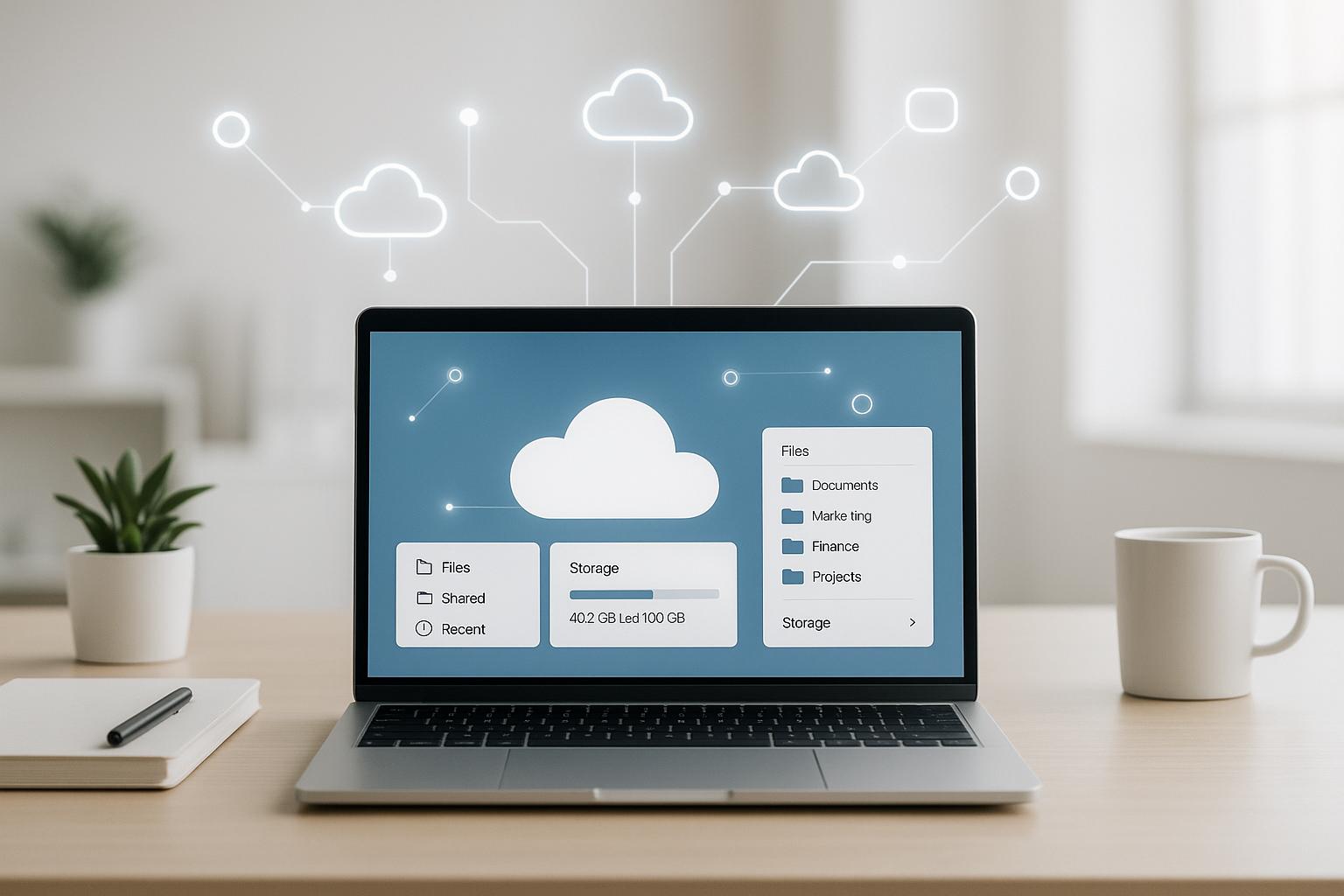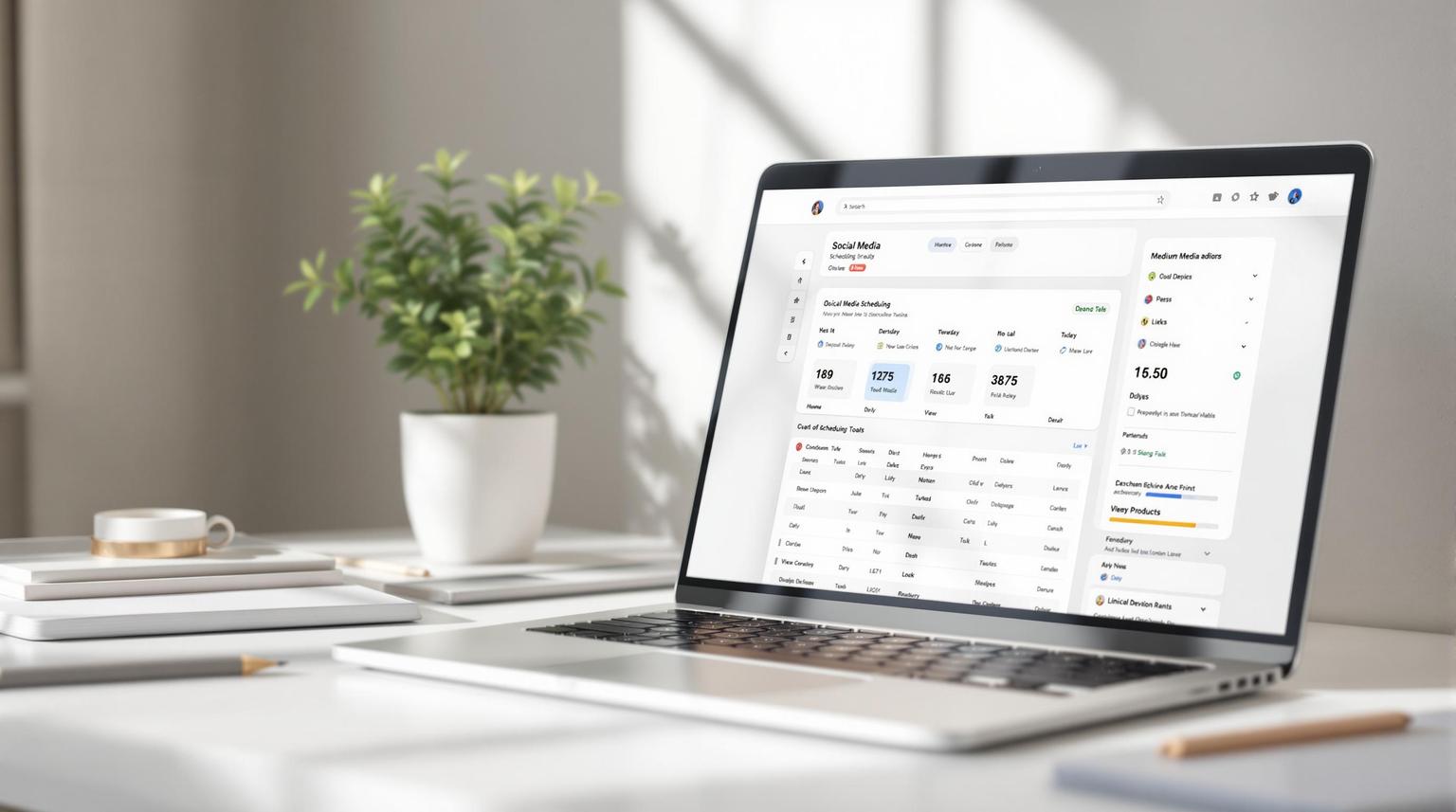Looking for the best in-app messaging tool? Here's a quick overview of the top 10 solutions that can help boost user engagement and drive revenue:
- Intercom - All-in-one customer messaging with AI chatbots ($29-132/seat/month)
- Firebase - Google's platform with real-time messaging (free tier available)
- CleverTap - Full customer engagement with AI-powered insights (custom pricing)
- MoEngage - Cross-channel messaging platform focused on behavior analysis ($999/month for 10k users)
- CometChat - Real-time chat with voice/video ($109-379/month)
- Braze - Enterprise-grade engagement platform ($60k-200k/year)
- OneSignal - Multi-channel messaging with free tier
- Airship - AI-powered messaging across channels (free and paid plans)
- Leanplum - Mobile-first engagement platform (custom pricing)
- UserGuiding - No-code messaging and onboarding ($69-499/month)
Quick Comparison Table:
| Tool | Best For | Starting Price | Key Feature |
|---|---|---|---|
| Intercom | All-around messaging | $29/month | AI chatbots |
| Firebase | Developer-focused | Free | Real-time database |
| CleverTap | Data-driven engagement | Custom | AI segmentation |
| MoEngage | Cross-channel campaigns | Custom | AI path analysis |
| CometChat | Real-time communication | $109/month | Voice/video chat |
| Braze | Enterprise needs | $60k/year | Advanced analytics |
| OneSignal | Basic messaging | Free | Push notifications |
| Airship | Cross-platform messaging | Free tier | AI personalization |
| Leanplum | Mobile apps | Custom | A/B testing |
| UserGuiding | User onboarding | $69/month | No-code builder |
Why These Matter:
- In-app messages get 20x more clicks than push notifications
- Apps using in-app messaging keep 2-3.5x more users
- Users open apps 30% more often with in-app messaging
Related video from YouTube
What Is In-App Messaging?
In-app messaging is a game-changer for user engagement. It's a way for businesses to chat with users right inside their apps. Unlike push notifications that pop up anytime, in-app messages only show up when someone's using the app. This makes them super relevant and timely.
These messages come in all shapes and sizes:
- Banners
- Tooltips
- Modals
- Full-screen overlays
They're not just for show. In-app messages can:
- Help newbies learn the ropes
- Shout about cool new features
- Offer personalized deals
- Ask for feedback
- Give real-time help
The best part? In-app messaging lets you get personal. By using what you know about your users, you can create messages that really hit home.
"Getting the timing right is probably the most important thing to consider when implementing in-app messages or in-app surveys. That's because context matters. With the right timing, you can show valuable information to your users when they most need it." - Moritz Dausinger, Co-Founder and CEO of Refiner
This personal touch matters. Apps that use in-app messaging keep 2-3.5 times more users than those that don't. That's huge!
Another big win? You don't need users to opt-in like with push notifications. You're in control of when and how messages pop up.
When done right, in-app messaging can work wonders. Take the US Open, for example. They used in-app messages to keep app users in the loop during the event:
- 53% of users opened live streaming notifications
- 32% clicked on last-minute ticket offers
These numbers show just how powerful in-app messaging can be.
But here's the thing: don't go overboard. Too many messages can annoy users and make them ditch your app. It's all about finding that sweet spot.
When picking an in-app messaging tool, look for one that:
- Lets you target specific user groups
- Offers different message styles
- Lets you test different versions
- Shows you how well your messages are doing
- Plays nice with your other marketing tools
Main Features to Look For
When picking an in-app messaging tool for your business in 2024, focus on these key features:
No-Code Editor
Go for platforms with easy-to-use, drag-and-drop editors. They let non-techies create and tweak messages fast, without bugging the dev team. This speed boost can really kick your messaging campaigns into high gear.
Rich Media Support
Look for tools that let you add images, videos, and interactive stuff to your messages. It makes them pop. Take Slack, for example. They use rich media in their in-app messages to explain new features quickly and visually. It's way more fun than a wall of text.
Advanced Segmentation
You want to be able to target specific groups based on how they behave, who they are, or how they use your app. The more personal you can make your messages, the better they'll perform.
Analytics and Reporting
You need solid analytics to see how your messages are doing. Look for platforms that show you the nitty-gritty: delivery rates, click-throughs, conversions - the works. This data is gold for making your messaging strategy better over time.
A/B Testing
Being able to test different versions of your messages is huge. It helps you figure out what content, timing, and format work best for your audience. It's like having a crystal ball for your messaging strategy.
Security and Compliance
With everyone freaking out about data privacy these days, you need a platform that takes security seriously. Here's what Aarathy Sundaresan from CometChat has to say about it:
"The ability to secure user data, protect privacy, and comply with international regulations is a non-negotiable attribute of any platform dealing with user data."
Look for end-to-end encryption, tight data access controls, and compliance with stuff like GDPR and CCPA.
Scalability
Your messaging tool should be able to handle more users and messages as you grow, without slowing down or crashing. You don't want your communication to fall apart just when your business is taking off.
Multi-Channel Support
While you're focusing on in-app messaging, it's smart to pick a tool that can handle other channels too, like push notifications or email. It makes for a smoother experience for your users across the board.
The cool kids on the block now offer automation and AI-powered insights to make your messages better. MoEngage, for instance, uses AI to help businesses send more personalized and timely messages. It's like having a super-smart assistant for your in-app campaigns.
How We Rated These Tools
We looked at five key areas when picking the top in-app messaging tools for 2024: setup, growth, costs, support, and device compatibility. Here's how we broke it down:
Setup Process
We checked how easy it is to get these tools up and running. Take Stream, for example. They offer a free 30-day trial and loads of help docs, tutorials, and community support. This makes setup a breeze compared to building your own messaging app from scratch, which can set you back $30,000 to $50,000 for basic features.
Growth Potential
Can these tools keep up when your user base explodes? That's what we wanted to know. CometChat, for instance, can handle 10,000 users a month without breaking a sweat. So your messaging won't lag behind as your business takes off.
Costs
Pricing isn't one-size-fits-all in this game. We looked at different approaches:
| Pricing Model | Examples | What It Means |
|---|---|---|
| MAU + Data Points | Braze, CleverTap | You pay based on Monthly Active Users and how much data you use |
| MTU | MoEngage, Mixpanel | Charges based on Monthly Tracked Users doing specific things |
| Device-based | Pushwoosh, OneSignal | You pay for the number of devices that can get push notifications |
The device-based model often gives you a clearer picture of what you're paying for, especially if you're running lots of marketing tests.
Support Quality
When things go wrong, you need help fast. We looked at how responsive each tool's support team is. CometChat, for example, offers round-the-clock email support and a community forum. That can be a lifesaver when you're trying to fix issues quickly.
Device Compatibility
We made sure these tools work across different platforms. MirrorFly, for instance, plays nice with iOS, Android, web, Angular, and Swift. That's great if your users are spread across different devices.
By focusing on these areas, we aimed to give you a clear picture of what each tool brings to the table. But remember, the best choice depends on what YOUR business needs. As Max from Quiq puts it:
"Choosing the right messaging platform takes thoughtful consideration and careful research."
Think about where your app is now, where it's going, and what features you can't live without. And don't forget your budget! With live chat software set to hit $1.7 billion by 2030, picking the right messaging tool could make or break your user engagement.
1. Intercom

Intercom is a top pick for in-app messaging in 2024. It's a one-stop shop for customer communication and engagement. Here's why it's a big deal:
Key Features:
Intercom does it all:
- Live chat widgets you can customize
- Support across channels (WhatsApp, Instagram, SMS)
- Chatbots powered by AI
- User onboarding with product tours
- In-app messaging that's targeted
Their AI agent, Fin, is a game-changer. It automates customer interactions, offering quick support and making things smoother for users.
Pricing:
Intercom's pricing fits different business sizes:
| Plan | Price (per seat/month) | What you get |
|---|---|---|
| Essential | $29 | Shared inbox, basic chatbots, help center |
| Advanced | $85 | Multiple team inboxes, advanced chatbots, proactive support |
| Expert | $132 | Workload management, multiple help centers, advanced reporting |
Heads up: SMS, WhatsApp, and email campaigns might cost extra. But if you're a startup, you're in luck. Intercom's Early Stage Program offers up to 90% off.
When to Use It:
Intercom works great for:
- Getting new users up to speed: Their Product Tours feature (an extra $199/month) lets you create interactive guides.
- Staying ahead of problems: You can set up messages based on how users behave, tackling issues before they pop up.
- Boosting sales: Chatbots can sort leads and send them to the right sales folks.
- Talking to customers everywhere: If you're on multiple platforms, Intercom keeps your communication consistent.
Real Impact:
While we don't have specific case studies, it's clear Intercom can make a big difference. By bringing all customer interactions together and automating responses, businesses can work smarter and keep customers happier.
What the Experts Say:
A customer service pro who's used Intercom said:
"Intercom has always been very friendly to start-ups."
This lines up with their Early Stage Program, showing they're serious about helping new businesses grow.
2. Firebase

Firebase, Google's BaaS platform, packs a punch with its in-app messaging system. Here's why it's a top pick for developers in 2024:
Key Features:
Firebase In-App Messaging lets you target active users with timely, context-based messages. You can create custom messages as cards, banners, modals, or images, and trigger them at just the right moment.
It plays well with other Google services too. You can use Firebase Analytics to fine-tune your messaging based on how users behave and who they are.
Pricing:
Firebase won't break the bank. Here's what it costs:
| Plan | Price | Features |
|---|---|---|
| Spark (Free) | $0 | 10,000 user authentications/month, 10 GB hosting storage, 5 GB cloud storage |
| Blaze (Pay-as-you-go) | Variable | No limits, pay for what you use |
Spark is great for starting out. Blaze lets you grow without worrying about hitting a ceiling.
When to Use It:
Firebase shines when you need:
- A messaging system that's quick to set up and can grow with you
- Real-time database management for instant messages
- One platform that has all your app development tools
It's especially good for mobile apps. In May 2023, over 6,030 Android apps were built with Firebase. That's a lot of developers putting their trust in it.
Real Impact:
While we don't have specific case studies, Firebase's popularity speaks volumes. Its real-time NoSQL database (Firebase Realtime Database) gives you 100 real-time connections for free. This means you can create in-app messaging that's snappy and engaging.
Krishi Shivasangaran, a digital marketing pro, says:
"Firebase is Google's own cloud-based application development framework to build high-quality mobile apps."
This shows that Firebase isn't just about messaging - it's a full package for building great apps.
Pro Tip: Use Firebase Analytics with your in-app messaging. You can create messages that really hit the mark by targeting specific groups of users.
In the world of in-app messaging tools, Firebase stands out. It's easy to use, can grow with you, and works seamlessly with Google's other tools. Whether you're just starting out or you're looking to step up your user communication game, Firebase has got you covered in 2024.
3. CleverTap
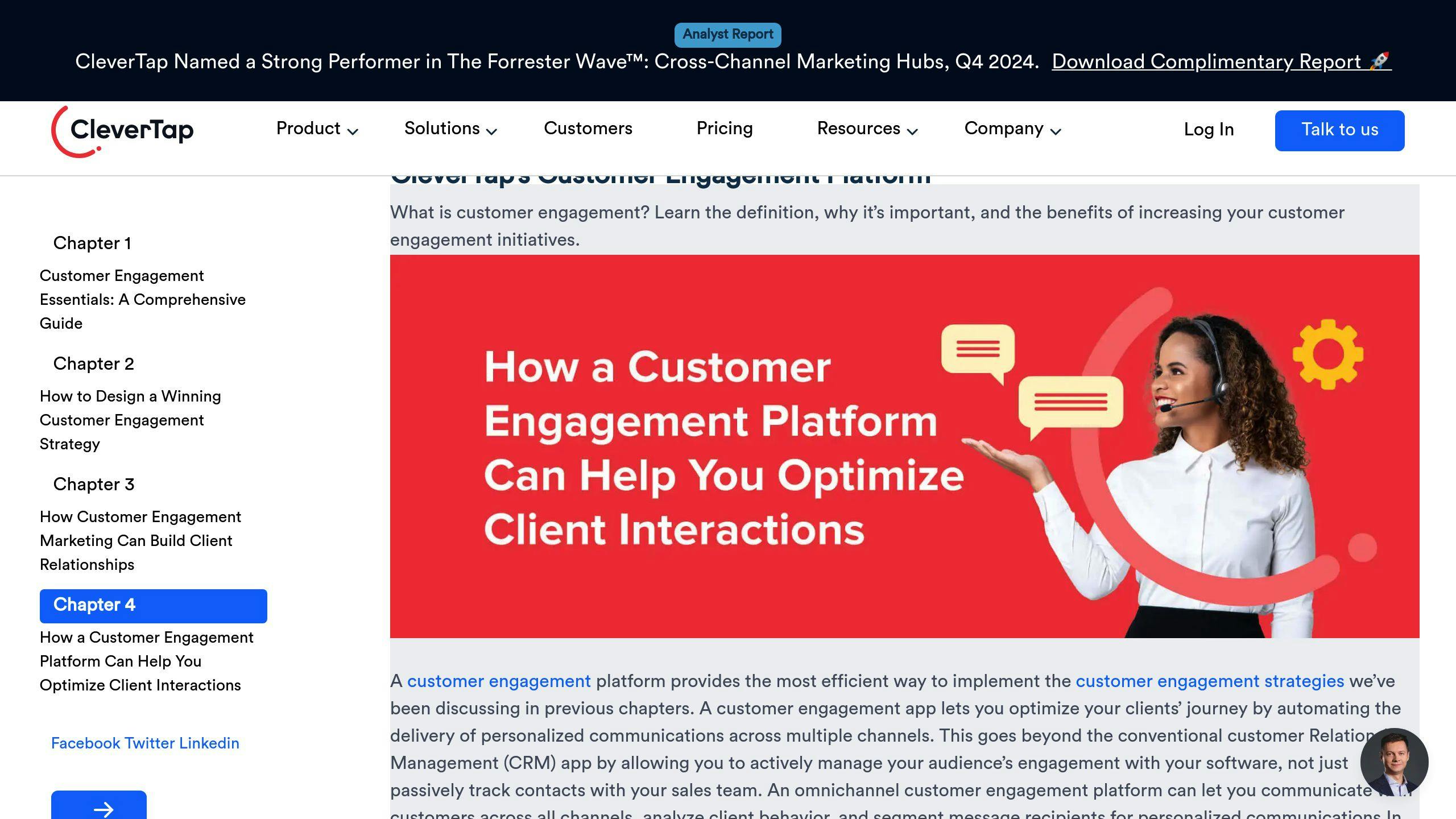
CleverTap isn't just another in-app messaging tool. It's a full-blown customer engagement platform that helps businesses boost their client lifetime value.
Key Features:
- Advanced behavioral segmentation
- Real-time analytics
- Multi-channel engagement (push, in-app, SMS, email)
- AI-powered predictive intelligence
- TesseractDB for high-speed data processing
CleverTap shines in creating tailored customer experiences across the entire lifecycle. Its AI component helps businesses make data-driven decisions and craft personalized campaigns.
Pricing:
CleverTap uses a subscription model with a 14-day free trial. They don't publicly share specific pricing, but it's based on Monthly Active Users (MAU) and data points. Here's a kicker: CleverTap can save you up to 40% on lifetime costs compared to some competitors.
"CleverTap is awesome if you have a mobile app and you constantly want your customers to access it." - Verified User, CMO (Chief Marketing Officer), Olsa Tools
When to Use It:
- User Retention: CleverTap keeps mobile users hooked. Its omnichannel approach brings user data together, making it easier to create cohesive messaging strategies.
- Scaling Businesses: With over 8,000 global brands like Disney+ Hotstar and Domino's using CleverTap, it's clear the platform can handle big operations.
- Data-Driven Marketing: The platform's analytics let you refine customer experiences in real-time. Use this to make smart decisions about your engagement strategies.
Real Impact:
Users have reported some big wins:
- Effective user acquisition and reactivation through remarketing
- Successful launch of omnichannel campaigns
- Better retention rates through targeted engagement
CleverTap's 'Lifecycle Optimizer' and 'IntelliNODE' features help automate campaigns and boost engagement. The platform also offers funnel and cohort capabilities to reduce app and website drop-offs.
One cool thing about CleverTap? It offers fair usage of up to 10,000 data points per user and a 10-year lookback period. This gives businesses a deep dive into their users' behavior over time.
But it's not all roses. Some users have reported issues with the user interface and customer service. And as you scale up, the pricing based on events rather than MAUs can get pricey, especially when you're dealing with billions of events.
In the world of in-app messaging tools, CleverTap holds its own with its feature set and potential cost savings. If you're looking to create data-driven, personalized customer experiences across multiple channels, CleverTap might be your go-to solution.
4. MoEngage
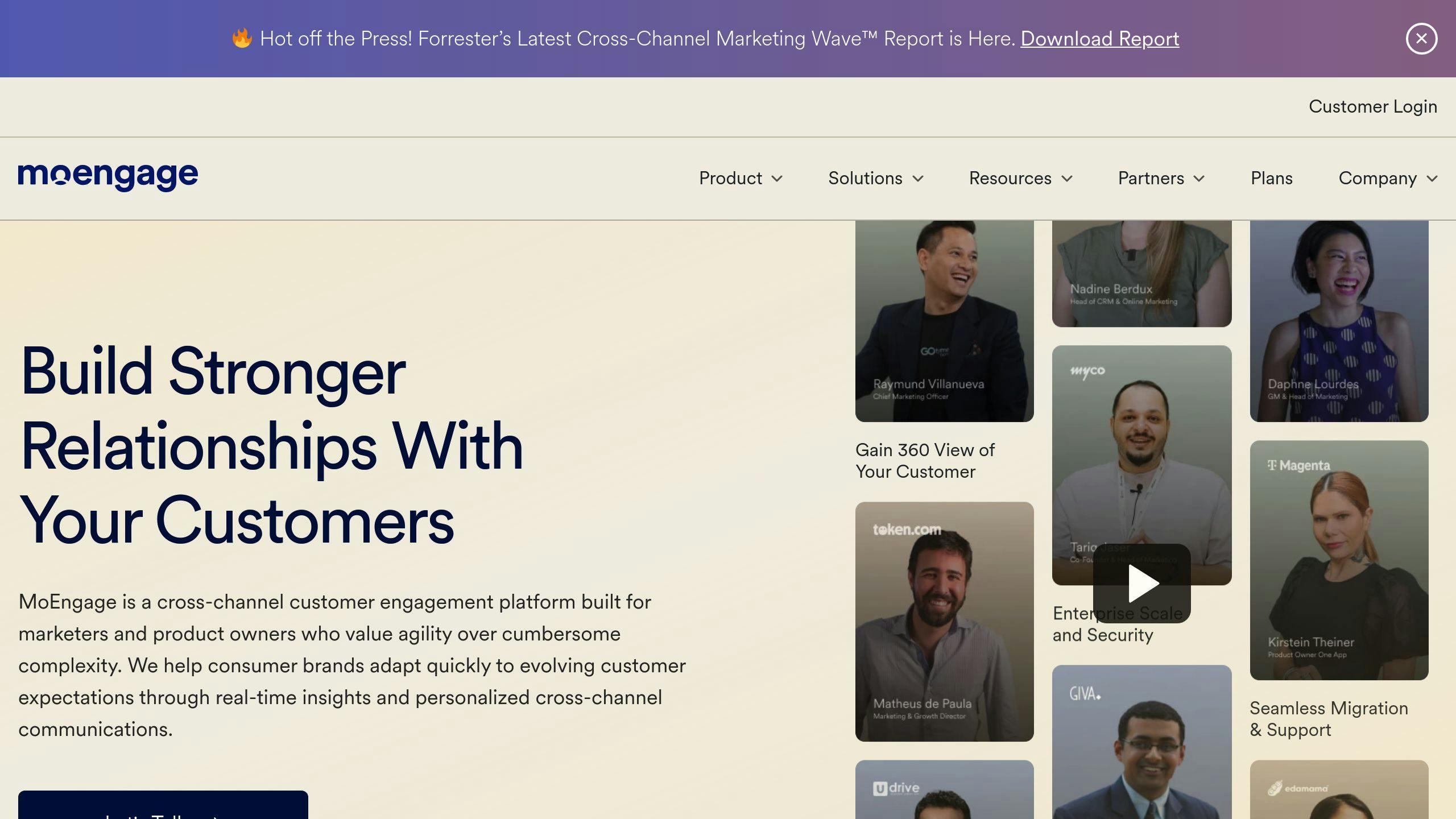
MoEngage is a top in-app messaging tool for 2024. It's an engagement platform that uses customer insights, perfect for mid-sized and big companies in e-commerce, media, and fintech.
What's Cool About It:
- Uses AI to figure out how users move through your app
- Splits up your users with machine learning
- Reaches out through push, in-app, SMS, and email
- Shows you what's happening right now
- Picks the best way and time to talk to users
MoEngage is great because it mixes customer info, real-time data, and different ways to reach out, all in one place. This helps marketers make messages that feel personal, no matter where they're talking to customers.
How Much It Costs:
MoEngage's prices change based on how many active users you have each month and what features you want:
| Plan | Who It's For | What You Get |
|---|---|---|
| Growth | Smaller companies | Basic user grouping, push notifications, emails |
| Pro | Medium-sized businesses | Better data tools, offline user groups, different languages |
| Enterprise | Big organizations | Push when users leave the app, expert help, custom stuff |
They don't share exact prices online, but people say it's good value for medium-sized companies, especially in growing markets.
When You Should Use It:
1. If you're big on data-driven marketing. MoEngage has smart tools that help you use customer info to make better campaigns.
2. If you want to reach customers in lots of different ways. MoEngage helps you keep your message the same across all platforms.
3. If you're focused on growing markets. MoEngage is really good for companies that do a lot of business in Asia and other up-and-coming places.
What People Say:
Here's what one user thinks:
"We have been using Moengage for around 10 months now. We create customer segments, plan weekend and daily campaigns and even transactional messages on WA and SMS. Nice experience overall."
This shows that MoEngage is good at splitting up customers and planning different kinds of messages.
Another user talks about how it helps save money:
"Moengage tool is used for running various marketing campaigns and optimizing them so as to enhance customer acquisition and retention."
These comments show that MoEngage can really help you talk to customers better and keep them coming back.
Hot Tip: Use MoEngage's smart path finder to automatically pick the best way and time to talk to users. This can make your messages work a lot better.
In 2024, MoEngage stands out because it's really good at using AI to understand customers and it works well for businesses all over the world. It's great at looking at data, reaching out in different ways, and it's easy to use. If you want to step up how you talk to customers, MoEngage is a solid choice.
sbb-itb-d1a6c90
5. CometChat

CometChat is an in-app messaging solution that lets businesses add real-time chat to their apps and websites. It works for many industries, from healthcare to e-commerce.
Key Features:
- Text, voice, and video chat
- One-on-one and group calls
- Real-time translation
- Push notifications and read receipts
- UI you can customize
CometChat's SDK and UI Kit make it easy for developers to add chat without tons of coding. It works on Android, iOS, and web apps.
Pricing:
CometChat's pricing is based on monthly active users (MAU):
| Plan | Price | MAU Limit |
|---|---|---|
| Essentials | $109/month | Up to 1,000 |
| Pro | $379/month | Up to 10,000 |
| Custom | Custom pricing | 50,000+ |
There's a free trial and a free plan for testing.
When to Use It:
1. Quick Development
If you need chat features fast, CometChat's no-code widget and low-code UI kits can help.
2. Handling Lots of Users
CometChat can handle over 1 million users at once in tests.
3. Multi-Platform Projects
It works with Flutter, React Native, and more, so it's great for cross-platform apps.
Laura Whittington from Live Group said:
"Straightforward implementation. We quickly created a POC, and in less than a week our testing was complete."
This shows how easy CometChat is to use.
Tip: Use CometChat's docs and sample code to set things up faster. Their UI Kit lets you make chat look how you want.
Keep in mind: Some users think it's expensive for big projects. As you grow, think about the costs vs. the features you get.
In the chat tool market, CometChat has a 0.02% share in Live Chat. It's small compared to Intercom's 17.59%, but CometChat focuses on letting you create custom chat experiences.
6. Braze
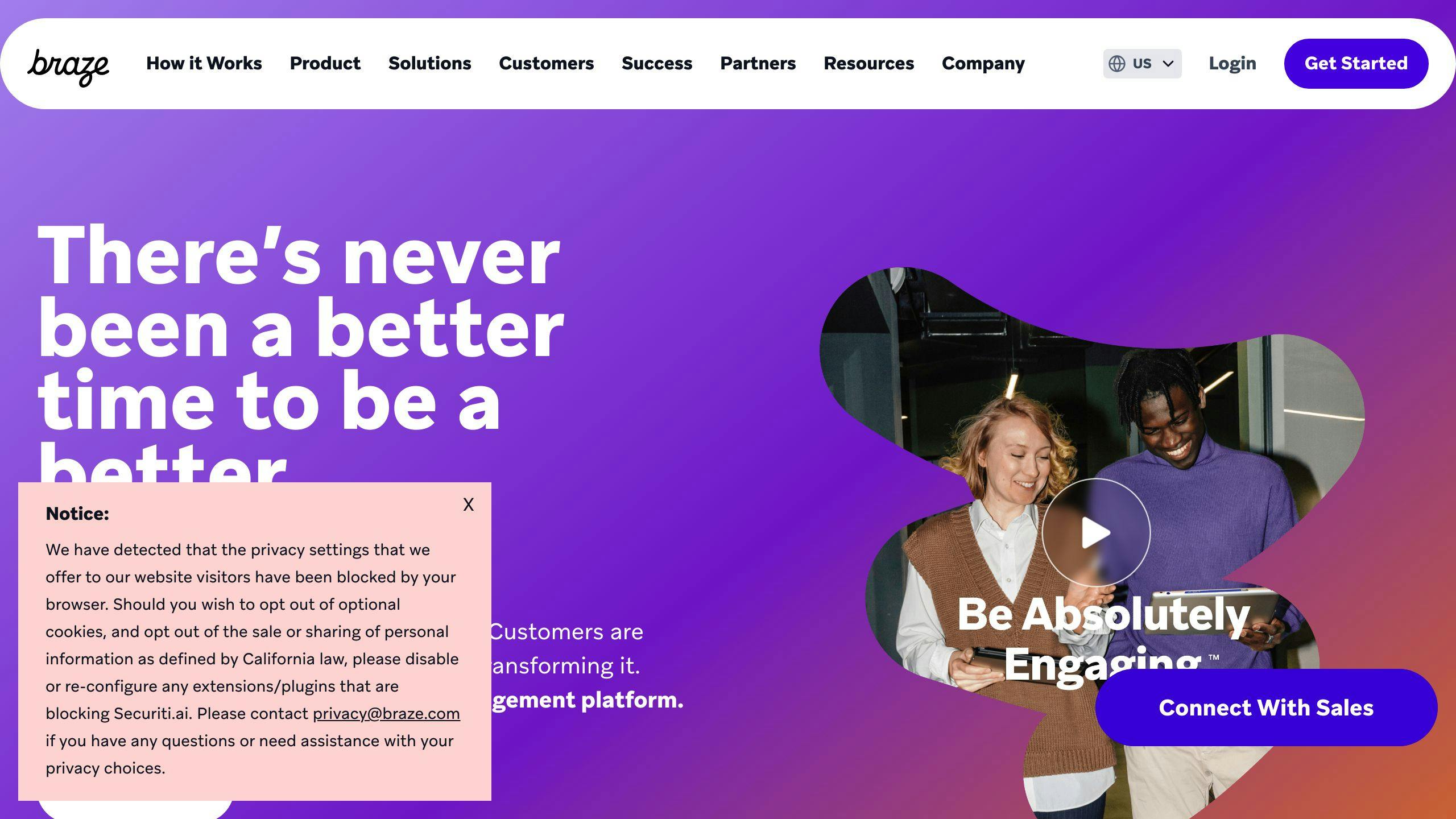
Braze is a big player in customer engagement. They offer tools for in-app messaging and multi-channel marketing campaigns. It's a good fit for bigger companies that want to create personalized, data-driven experiences for their customers.
What Braze Does:
- Sends messages across different channels (push, email, in-app, SMS)
- Uses AI to personalize and segment customers
- Provides real-time data analysis and reports
- Automates targeted campaigns
Braze is great at creating smooth customer journeys across different touchpoints. For example, Urban Outfitters used Braze and saw their average revenue per recipient jump by 146% in one campaign.
How Much It Costs:
Braze doesn't share their prices publicly, but here's what we've found out:
| Plan | Yearly Cost (Est.) | Monthly Active Users |
|---|---|---|
| Growth | $60,000 | Up to 50,000 |
| Business | $120,000 | Up to 250,000 |
| Enterprise | $200,000+ | No limit |
These prices might make you gulp, especially if you're a smaller business. But if you have a lot of users, Braze's features might be worth the investment.
When Braze Might Be Right for You:
1. You're growing fast
If your user numbers are shooting up, Braze can handle millions of users.
2. You love data-driven marketing
Braze's advanced analytics and AI can help you create super-targeted campaigns based on how users behave.
3. You use lots of different marketing channels
If you're reaching out to customers in many ways, Braze can help you keep your message consistent across all of them.
Here's what Kristijan A., a Lifecycle Marketing Manager, says about Braze:
"Braze has all you need to run engage, retain, and convert your mobile app users - from detailed segmentation to running workflows and multivariate testing with multiple messages across Email, Push Notifications, In-App Messages, News Feed Cards, SMS, and more."
This shows how Braze covers all the bases when it comes to customer engagement.
Insider Tip: When you're talking to Braze about pricing, come prepared with info about what you need and how much you'll use. Try starting these talks a few weeks before the end of a quarter - you might get a better deal. And don't forget to ask if there's any wiggle room on implementation fees.
Braze isn't cheap, but its powerful features and proven results make it a top choice for businesses that are serious about stepping up their in-app messaging and customer engagement in 2024.
7. OneSignal
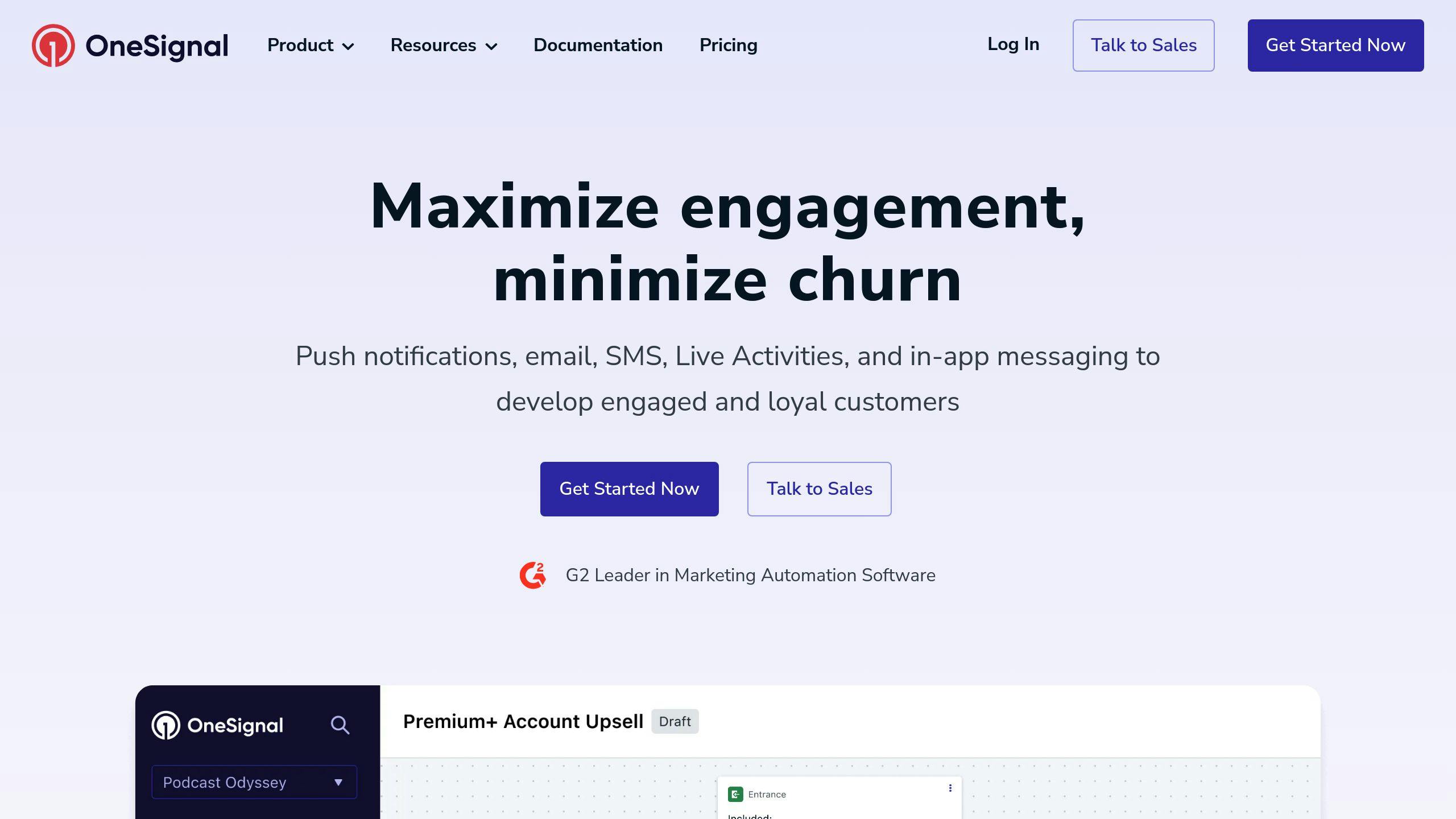
OneSignal is a customer engagement platform that packs a punch in 2024. It's not just about push notifications - they've got in-app messaging, email, and SMS too. Whether you're a small startup or a big corporation, OneSignal's got your back for boosting user engagement and driving those sweet, sweet revenues.
What's Cool About OneSignal?
- Create in-app messages without touching code
- Slice and dice your user base for targeted campaigns
- Test different versions to see what sticks
- Get the lowdown on your campaigns with real-time data
- Works on pretty much everything (Android, iOS, web, you name it)
Got a time-sensitive promo? Need to push out a critical update ASAP? OneSignal's drag-and-drop interface lets even your non-techie team members whip up in-app messages in no time.
Show Me the Money
OneSignal's got plans for every wallet:
| Plan | Price | What You Get |
|---|---|---|
| Free | $0 | Unlimited push subscribers, 1 active in-app message, 10,000 emails/month |
| Growth | $9/month + usage | 20,000 free emails/month, 10 segments, 3 customer journeys |
| Professional | Custom | 20 segments, 100 data tags, 20 journeys (up to 50 steps each) |
| Enterprise | Custom | The whole shebang with bells and whistles |
If you're just starting out, that Free Plan looks pretty sweet, right?
When OneSignal Shines
- You need in-app messaging yesterday
- Your app is everywhere (Android, iOS, web) and you want consistent messaging
- You're all about that data-driven life for your messaging campaigns
Don't just take our word for it. Check out what one happy customer had to say:
"OneSignal has helped us reach our online customers through push and in-app messages. Engagement has increased at least 100% since we started."
Pro Tip: Use OneSignal's permission prompts to boost your push notification opt-ins. Tell users what's in it for them, and watch your reach grow beyond just in-app messages.
Now, let's keep it real. OneSignal's got a ton of features, which is awesome, but it might take a bit to get your head around everything. But hey, if you're willing to put in the time, the payoff can be huge.
In the wild world of in-app messaging tools for 2024, OneSignal's mix of user-friendliness, powerful features, and flexible pricing makes it a solid choice for businesses looking to step up their user engagement game.
8. Airship
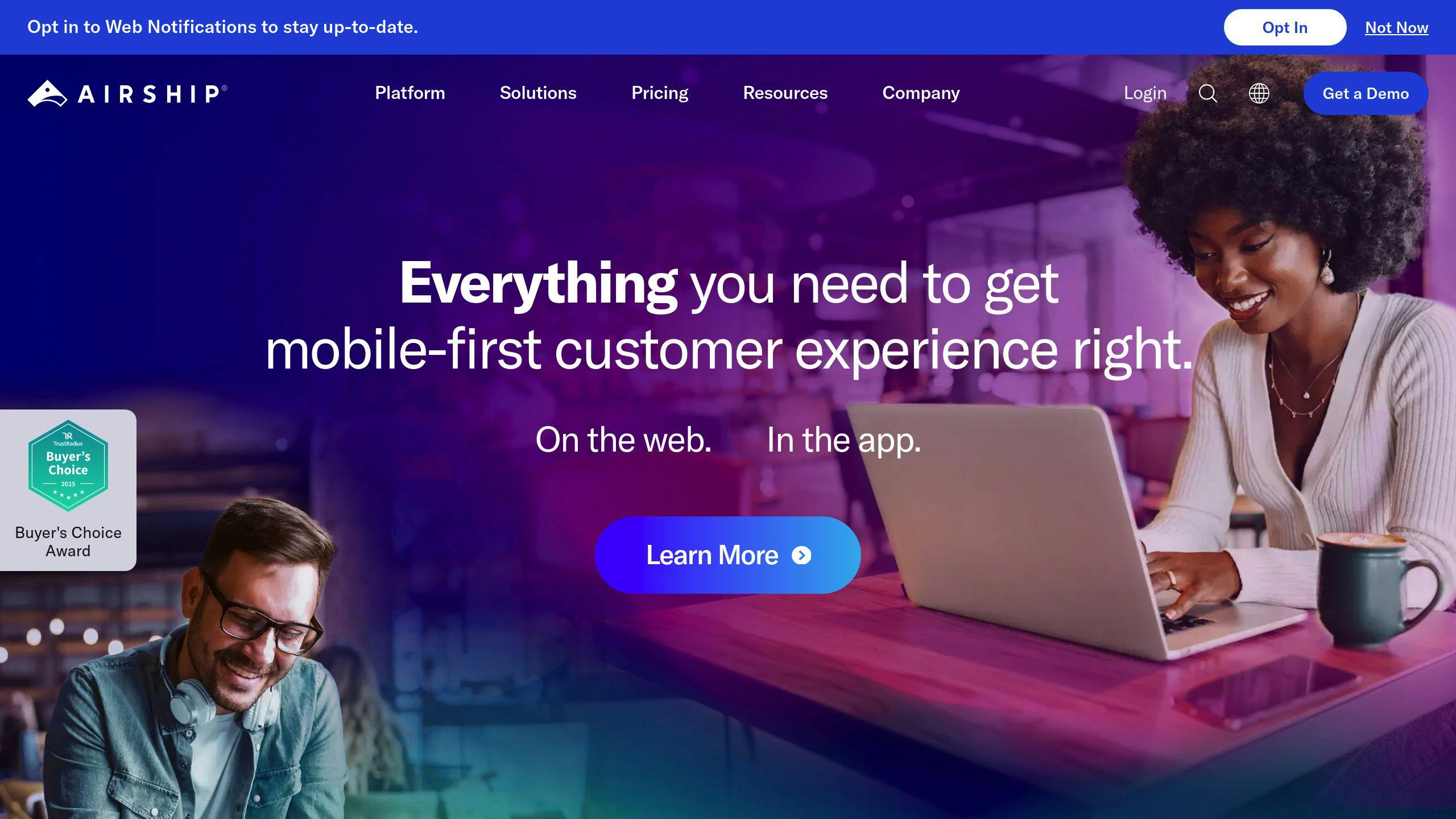
Airship is a top-notch in-app messaging tool for 2024. It's not just about push notifications anymore - Airship has grown into a full-fledged customer engagement platform.
Here's what Airship brings to the table:
- Messages across multiple channels (push, email, in-app, SMS)
- AI that personalizes user experiences
- An API that plays nice with any JSON-compatible platform
- Smart user targeting
- Real-time data on how your messages are performing
Airship uses AI and user data to send the right message at the right time. It's all about building trust and getting users to engage more.
What'll It Cost You?
Airship has two main plans:
- AXP Essentials: It's free! You get push and web notifications, easy app setup, and basic stats.
- AXP Enterprise: You'll need to get a custom quote. It includes email, SMS, mobile wallet, and more advanced features.
The free plan is great for dipping your toes in. If you need more, the Enterprise plan can be tailored to fit.
When Airship Shines:
- You're running campaigns across different platforms
- Your business is growing fast and you need a tool that can keep up
- You have unique messaging needs that require custom integration
- You want to use data to drive your marketing decisions
Airship works well for many industries. While we don't have specific case studies, the company has been around for a while and keeps improving its tech.
One cool thing about Airship is that it supports web push notifications and Scenes on both desktop and mobile. This means your messages look good no matter what device your users prefer.
Pro Tip: If you run into 503 errors, use the Exponential Backoff and Retry method. It helps keep things running smoothly when there's a lot of traffic.
Airship takes privacy seriously. They support double opt-in and follow local data privacy laws. This is crucial if you're doing business in places with strict privacy rules.
Keep in mind that Airship has a lot of features, so it might take some time to learn. But if you're after a powerful in-app messaging tool that can do it all, Airship is worth checking out in 2024.
9. Leanplum
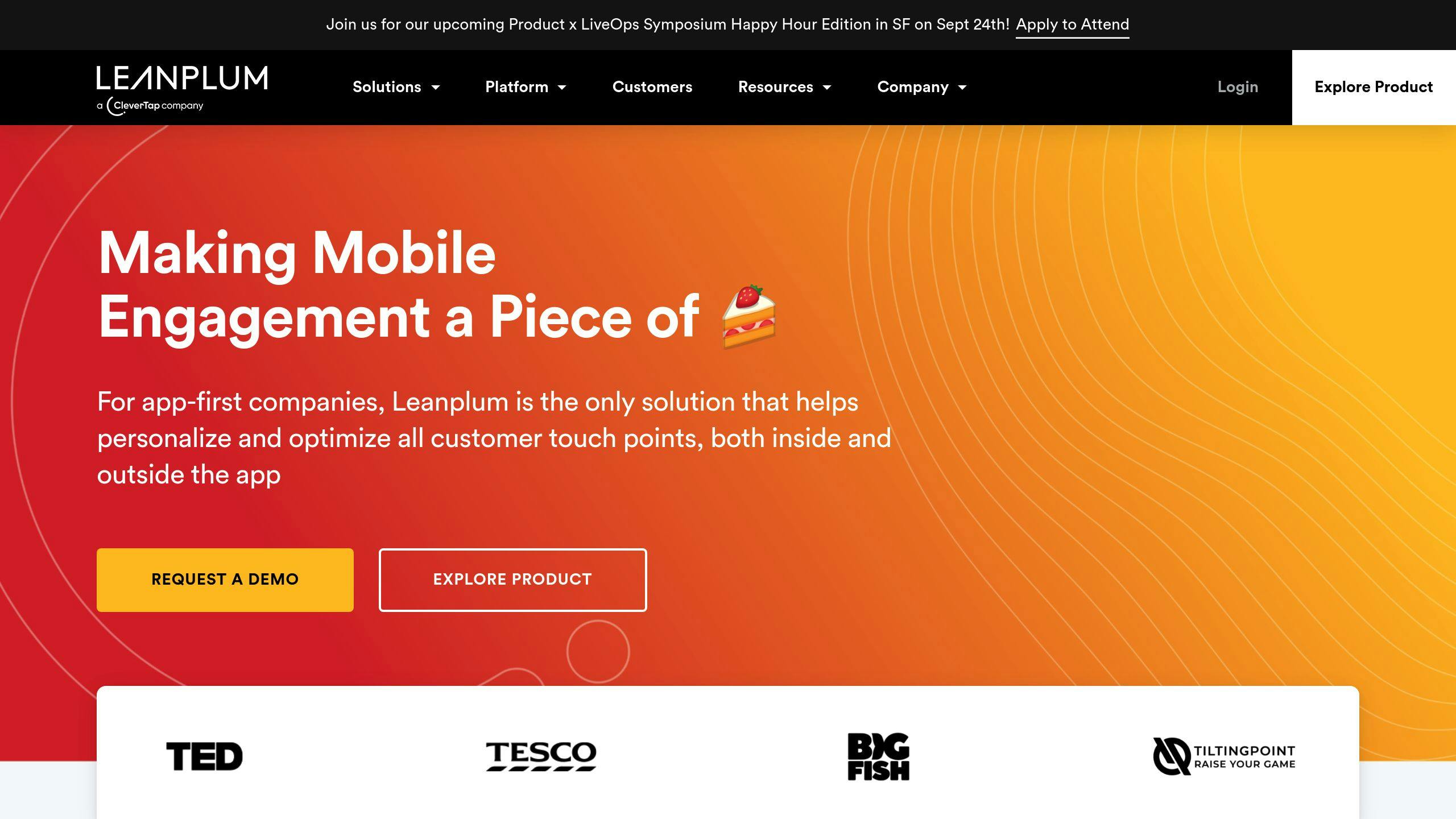
Leanplum is a mobile-first engagement platform that's making waves in 2024. It's built for app-centric companies who want to supercharge their customer interactions.
What's in the box?
- A/B testing
- Analytics
- Campaign segmentation
- Push notifications
- Email marketing
- Cross-channel messaging (SMS, in-app, push)
Leanplum's secret sauce? It's mobile-first from the ground up. Unlike tools that tacked on mobile features later, Leanplum was born for mobile engagement. This shows in its slick interface and powerful mobile-specific features.
Here's what a marketing pro from the IT world had to say:
"Leanplum mobile engagement platform enables cross-channel marketing. We can send the SMS/MMS campaigns. We can check the analytics from the dashboard. This is a trustworthy platform."
Show me the money
Leanplum offers a free version and a free trial. For the big guns, they've got custom enterprise plans. Want specifics? Drop a line to sales@leanplum.com.
When to pick Leanplum
- You're all about that app life
- You're a sucker for A/B testing
- You want a platform that's both brainy (analytics) and chatty (messaging)
Leanplum's not just for the big fish. With a 4.6 out of 5 scalability score (based on 53 ratings), it's ready to grow with you.
Real talk
A management consultant in IT services spilled the beans:
"Leanplum makes it easy for our team to drive user engagement in order to maximize lifetime value and create lasting relationships."
Pro tip: Get the Leanplum mobile app. One user raved, "Creating digital marketing campaigns have become very easy with Leanplum and I can always update and review anything with my Leanplum phone app."
Heads up: Some users find Leanplum less intuitive than competitors like Braze. There might be a learning curve, but for app-focused businesses, the mobile-specific features could be worth it.
In the 2024 in-app messaging tool showdown, Leanplum's mobile-first approach and feature-packed offering make it a strong contender, especially if you're all about app engagement and data-driven marketing.
10. UserGuiding
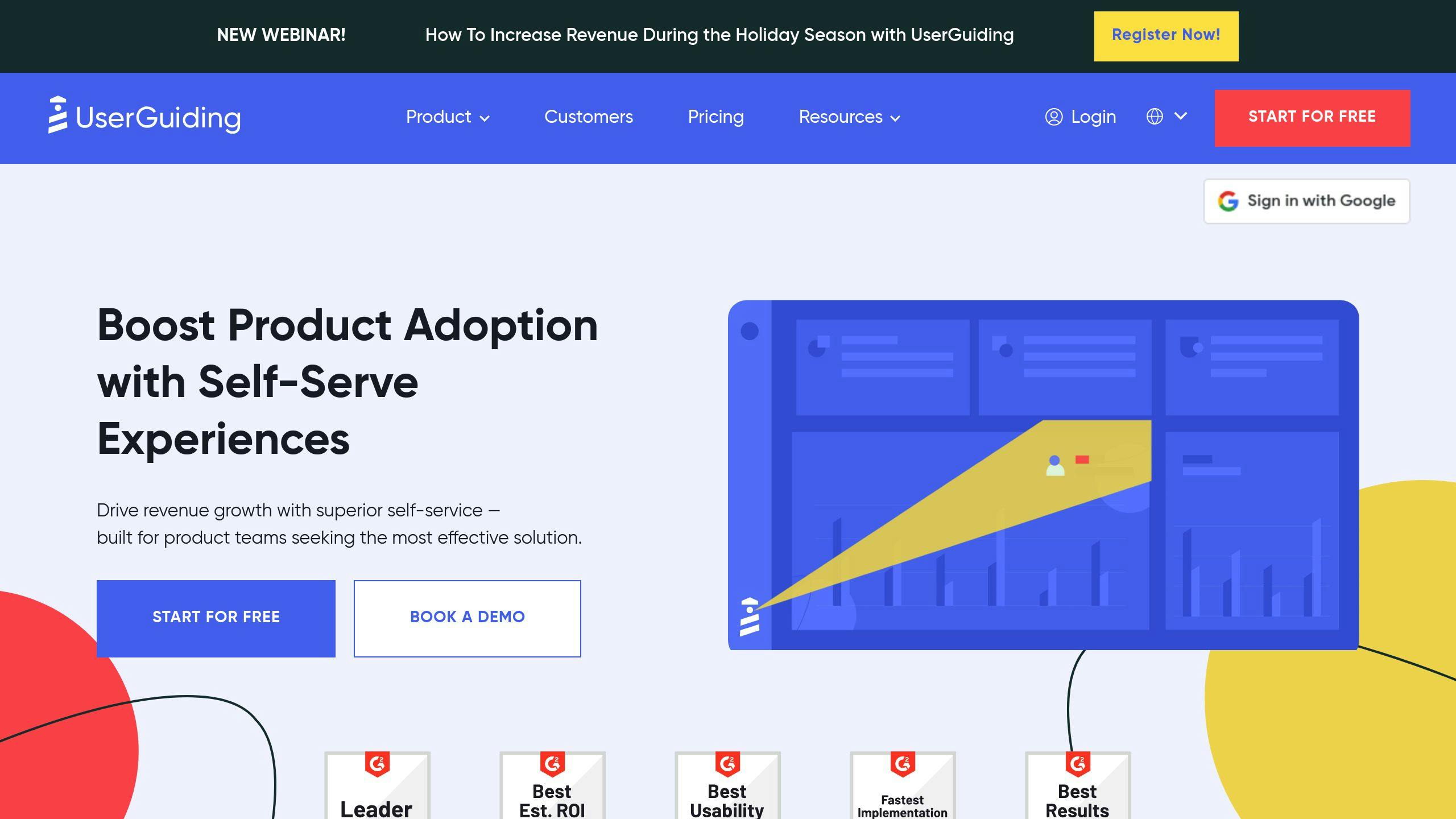
UserGuiding is shaking things up in the in-app messaging world. It's a no-code digital adoption platform that lets businesses create interactive product tours, onboarding flows, and in-app messages without writing a single line of code.
Here's what UserGuiding brings to the table:
- Interactive guides and walkthroughs
- User onboarding checklists
- Tooltips and hotspots
- In-app messaging
- Resource centers
- NPS surveys
What makes UserGuiding stand out? It's all about simplicity. You don't need to be a tech whiz to create engaging in-app experiences. This makes it perfect for small to medium-sized businesses who want to boost user engagement without emptying their wallets.
Pricing:
UserGuiding keeps it simple with three main plans:
| Plan | Price (billed annually) | Monthly Active Users |
|---|---|---|
| Basic | $69/month | Up to 2,500 |
| Professional | $299/month | Up to 20,000 |
| Corporate | Starts at $499/month | Unlimited |
Not sure if it's right for you? No worries. All plans come with a 14-day free trial and a 30-day money-back guarantee. That's plenty of time to kick the tires.
When to Pick UserGuiding:
- You're a startup or SMB looking for a budget-friendly in-app messaging solution
- You want to create product tours and onboarding flows without coding
- You need to boost user engagement and retention
UserGuiding really shines when it comes to creating contextual in-app experiences. Don't just take my word for it. Here's a success story from the UserGuiding team:
"We tried to put an article from the blog in one of the in-app messages that would appear contextually. Here's the funny part: We tried it out for only one day and got one of our trial users using the app to check out the article, which then convinced them to make a purchase."
That's the power of well-timed, relevant in-app messaging in action.
Pro Tip: Want to supercharge your results? Use UserGuiding's segmentation features to target specific user groups with tailored messages. It's a game-changer for engagement and conversion rates.
Is UserGuiding perfect? No tool is. It might not have all the fancy features of some big-name enterprise tools. But if you're looking to dip your toes into in-app messaging in 2024, UserGuiding's user-friendly interface and wallet-friendly pricing make it a solid choice.
Tool Comparison
Let's compare the top in-app messaging tools for 2024. We'll look at their features, prices, and how well they work with other software.
Pricing and User Limits
Here's how our top picks compare for price:
| Tool | Price for 10,000 Users/Month | Free Trial |
|---|---|---|
| Intercom | $85/seat/month (Advanced plan) | Yes |
| Firebase | Pay-as-you-go | Yes (Spark plan) |
| CleverTap | $75/month | 30-day trial |
| MoEngage | $999/month (after 10,000 MTUs) | Not specified |
| CometChat | $379/month | Yes |
Intercom and CleverTap are cheaper for fewer users. But as you grow, MoEngage might cost less.
Key Features
Each tool has its strong points:
- Intercom: AI chatbots, product tours, advanced segmentation
- Firebase: Real-time database, analytics, easy Google integration
- CleverTap: AI segmentation, omnichannel messaging, predictive analytics
- MoEngage: AI user path analysis, cross-channel campaigns
- CometChat: Voice and video chat, real-time translation, custom UI
Integration Capabilities
Your in-app messaging tool needs to work well with your other tech. Here's how they do:
- Intercom: Works with lots of tools, like Salesforce, Slack, and Jira
- Firebase: Works great with Google services, not many other options
- CleverTap: Works with many tools, like Segment, Mixpanel, and Zapier
- MoEngage: Works with big marketing and analytics platforms
- CometChat: Has SDKs for different platforms, including React Native and Flutter
Real-World Performance
Let's look at some actual results:
OneSignal (not in our top 5) said their customers kept 27% more app users with in-app messaging. This shows how much good in-app messaging can help.
Over 25,000 businesses use Intercom, including big names like Amazon and Meta. Their AI tools have helped companies cut support costs and make customers happier.
Expert Insight
Aarathy Sundaresan from CometChat says:
"Choosing the right SDK can mean the difference between providing a stellar chat experience that your users will love or a scrappy one that will leave them wanting more."
This shows how important it is to pick the right tool for your needs.
Final Thoughts
When picking an in-app messaging tool, think about what you need now and in the future. Intercom and CleverTap are good for all sizes of business. Firebase is great if you use other Google tools. MoEngage is strong in AI engagement, and CometChat offers unique features like voice and video.
Final Thoughts
Picking the right in-app messaging tool can make or break your user engagement in 2024. Let's break down what we've learned from our top 10 picks:
1. Personalization is key
AI-powered tools like Intercom and CleverTap deliver tailored messages. Why? Because 71% of consumers expect personalized interactions, according to McKinsey.
2. Timing matters
OneSignal and Airship are great at hitting the right moment. Fun fact: in-app messages get 8x more direct responses than push notifications.
3. Multi-channel is a must
MoEngage and Braze cover all your bases. Users hop between different touchpoints, so you need to be everywhere.
4. Data drives decisions
Firebase and Leanplum give you the analytics to understand your users and fine-tune your strategy.
5. Keep it simple
UserGuiding's no-code approach makes life easier for non-techies.
Now, let's talk strategy. Here's how to make your in-app messaging work:
- Set clear goals. What do you want? Better onboarding? More feature use? Higher conversions?
- Know your audience. Use data to target your messages. As one expert put it:
"The better you use in-app messages, the stronger you will get in engaging with your users."
- Keep it short and sweet. Don't overload users with info.
- Test, learn, repeat. A/B testing is your friend. Leanplum makes this easy.
- Respect your users. Don't bombard them with messages.
Remember, it's not just about the tool. It's about creating a smooth, valuable experience for your users. Maria Krisette Lim, a Content Marketing Specialist, says:
"Integrating in-app messaging into your customer retention strategy can significantly impact the success of your app."
Choose the right tool, follow best practices, and watch your app become an engagement powerhouse. Whether you're a startup on a budget (hello, UserGuiding) or a big company wanting AI magic (looking at you, Braze), there's a tool for you.
In 2024, success means personal, timely, and valuable messages that make your app better. Choose smart, and watch your user engagement take off.
FAQs
What is the best messaging SDK?
Picking the right messaging SDK boils down to your specific needs. Here's a rundown of some top contenders in 2024:
MirrorFly packs a punch with over 150 chat features, including VoIP calls and live broadcasts. It's a solid choice for businesses, starting at $299/month.
CometChat is all about security and scalability. They offer a 'Sandbox' package with voice and video calling, perfect for small businesses. Plans kick off at $119/month.
Sendbird is feature-rich, supporting various communication types and media sharing. But it comes with a heftier price tag, starting at $399/month.
On a budget? PubNub might be your go-to. Plans start at $98/month, and it's known for speedy performance and support for both direct and group chats.
Twilio offers a pay-as-you-go model, giving you flexibility. They've powered over 795 billion interactions with a rock-solid 99.999% API uptime.
When you're SDK shopping, keep these factors in mind:
- How much can you scale?
- What's your budget?
- What features do you need?
- How easy is it to integrate?
- Is the support and documentation up to snuff?

